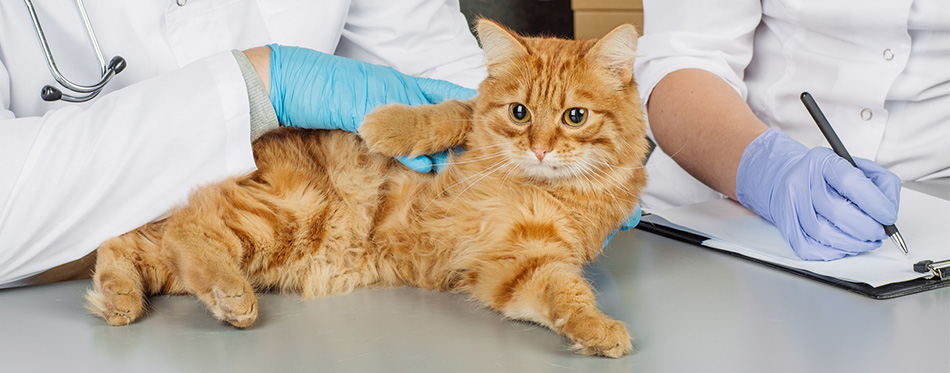Just like humans, cats can suffer from chronic inflammation of the small passageways in the lungs, also known as asthma. While incurable, feline asthma is manageable with the right treatment and medication. Do you suspect your kitty is suffering from asthma? Don’t worry, with the right care, your pet can lead a happy and active life! Here’s how you can recognize the symptoms on time, seek early treatment, and reduce the chance of your cat suffering an asthma attack.

How Your Cat Breathes
The lower respiratory tract is the lower part of the airways that we use for breathing. It includes the two bronchi (one left and one right) that lead into the smaller tubes called bronchioles and the little sacs called alveoli that make up the lungs. The structure of each lung is very like a tree with progressively smaller branches the further you get away from the trunk.
If you think of the main airway that leads down from the mouth and the nose as the trunk, this is called the trachea. Half way down the chest, this splits into two branches which are called bronchi. These also split into smaller branches called bronchioles. At the end of the bronchioles are the alveoli – you can think of these as the leaves of the tree. They are very important because this is where the exchange of oxygen and carbon dioxide takes place. They have a very good blood supply and a very thin wall. Oxygen from the air, crosses the wall and enters the blood stream. From here it is carried by the blood all around the body. As the body uses the oxygen, it produces a waste product which is carbon dioxide. This passes back into the blood and moves into the alveoli where it is breathed out of the body when your cat exhales.
The respiratory system must be working properly for your cat to be able to get enough oxygen and to get rid of carbon dioxide efficiently.
What Can Go Wrong With the Respiratory Tract – Feline Asthma
Sadly, things can go wrong with your cat’s respiratory tract. Any part of the structure, including the bronchi and bronchioles can become inflamed – this is called bronchitis. The inflammation can be acute (where it comes on suddenly) or chronic (where it is long-standing).
So, where does asthma fit into all of this? The condition of asthma can be associated with both acute and chronic inflammation of the lower respiratory tract. However, as in humans, it is most often a chronic inflammation. Untreated chronic inflammation of the lower respiratory tract can lead to fibrosis which is a buildup of excess fibrous tissue in the lungs. In severe cases, this can eventually lead to lung atelectasis which is a condition where the lungs cannot inflate.
Some cats are at a higher risk of developing asthma than others. The condition can occur at any age but is most common in cats aged between two and eight years of age. It is more common in female cats and some breeds are more at risk. If your kitty is a Siamese or a Himalayan, this is certainly something that you should be on the lookout for because they have a genetic predisposition for this disease. This means that it runs in cat families.
Feline asthma is an immunity-related condition which means that it is the body’s own immune system that is causing the symptoms. It is a type of allergic reaction so the body is reacting to a stimulus of some kind – the thing that is causing the allergic reaction is called an allergen. The body reacts by narrowing the airways and sending special cells to the area to try to fight off what it (wrongly) perceives to be a threat. There are several triggers for feline asthma and these include stress, several types of pollen, molds, tobacco smoke, dust mites, some types of cat litter, household cleaning products and some commercial cat food ingredients.
Check out our guides on Cat Litter Boxes and Self-Cleaning Litter Boxes for more info.
It is important to spot and treat feline asthma promptly to avoid more serious complications. However, the condition cannot be cured. Thankfully, it can be managed using the correct care program and medication. In fact, most cats with asthma can lead active and happy lives!

Symptoms of Asthma in Cats
In order to spot asthma in your cat and seek appropriate treatment, you need to know what the signs are. The main symptoms of asthma in cats are associated with their breathing.
- Changes in your cat’s breathing: You may be able to hear your cat wheezing as they breathe. You may also notice that they are breathing rapidly or that they are having to make an effort to breathe. They may be struggling to get any breath in at all. These symptoms may be particularly noticeable after your cat has been exercising.
- Coughing: If you have noticed that your cat is constantly coughing or if they seem to be gagging, this can be a sign of asthma. You may mistakenly think that they have a hairball. There may even be a gurgling sound in the throat that you can hear. Some cats with asthma seem to be swallowing all the time too. For more options head over to our guide on the best cat food for hairballs.
- Visible signs: You may spot some visible signs of asthma. Your cat may have frothy mucus coming out from their mouth when they are coughing. You may have noticed that they keep their mouth open when they are breathing or they may extend their neck upwards and appear to be gasping for breath. You may also notice that they squat with their shoulders hunched and their neck extended whilst they are low to the ground. Often, a cat with asthma will have blue lips and gums. This is a sign that their body is not getting enough oxygen.
- Behavior: Often a cat with asthma will start to behave differently. They may not move around as much as they used to and may appear lethargic. They may also have a general weakness.
If you have noticed that your cat has any of these symptoms, you must make an appointment to see your vet. It is important that you do this even if the symptoms come and go and are not present all the time. Any sort of coughing or wheezing is a serious issue for cats even if it is not asthma – it could be a lung infection. Whatever the cause, it means that the lungs are inflamed and they could develop permanent scarring if it is not treated.
Learn how to measure your cat’s respiratory rate – this is the number of breaths that they take per minute and is a good indication of how their lungs are working. A normal healthy cat will take around 24 to 30 breaths every minute when they are sleeping or resting. If your cat is taking over 40 breaths per minute when they are resting, it is time to contact your vet. However, snoring or loud breathing is not necessarily a sign of asthma, some cats just snore!
Signs of a Feline Asthma Attack
An asthma attack is a potentially dangerous situation for your cat just as it is for a human. In a less serious asthma attack, your kitty may start coughing and find it hard to stop. You may notice that they hold their neck out straight and typically they will keep their head close to the ground. You may be able to hear them wheezing as well. This can be distressing but it is likely that your cat will recover. However, when this has happened once, you should make an appointment with your vet to discuss it.
A full-blown asthma attack is more serious. You will notice that your cat is clearly struggling to breathe and their sides will be heaving in and out. They will not look at all well and will be doing nothing else but focusing on trying to get breath into their body. As things get more serious, they may start panting and will look frightened. You may notice that they are coughing up mucus or they may be drooling excessively. If this is happening, they need immediate medical attention so get them to the vet straight away.

Treatment of Feline Asthma
Before any treatment for feline asthma can begin, it is important to get a correct diagnosis. Only your vet can do this. Do not try to diagnose the condition yourself because there can be other conditions, such as a lung infection, that cause similar symptoms.
Diagnosing Asthma in Cats
Your consultation will start with your vet asking you to explain why you are concerned about your cat. If the symptoms are intermittent, your cat may be symptom-free when you are with the vet and so you must be able to accurately describe what has happened or show your vet a video.
There is no simple asthma test that is used for a diagnosis. In fact, most vets will start by ruling out other potential causes of the symptoms such as heart disease, respiratory infections, and heartworm.
Your vet will need to listen to your cat’s lungs using a stethoscope. It is also likely that they will take a blood test which will look for high levels of white blood cells – this indicates an allergic response. If these initial tests indicate that your kitty has asthma, they may need a chest X-ray to look at the lungs. This will show if they have over-inflation (because they cannot breathe out fully), a partially collapsed lung or a flat diaphragm. These are all signs of asthma but not all cats with asthma will have these signs on an x-ray especially in the early stages.
Finally, your vet may carry out a Bronchoalveolar Lavage (BAL) in which they take mucus from the small airways and examine it under a microscope. If they find a type of white blood cell called an eosinophil, it is highly indicative of asthma.
Treatment of Feline Asthma
Vets use two main treatment approaches for feline asthma. The first approach is to use anti-inflammatory drugs which are designed to reduce the inflammation that causes asthma. A type of drug called corticosteroids are very good at doing this. The second approach is to use a bronchodilator medication. This is a type of drug that opens up the air passages and makes it easier for your cat to breathe.
Most cases of feline asthma respond well to this medication. However, if further treatment is needed, a course of antihistamine drugs may also be prescribed to dampen down the immune response that is causing the problem in the first place.
You will be responsible for giving your cat their medication so it is important that you understand how to do that correctly. Often, it is given in an inhaler so your cat breathes it in. However, it can be in tablet or injection form. You will need to learn how to use the inhaler correctly – it is not the same as when a human uses an inhaler because you cannot tell your cat to take a deep breath!
Treating a Feline Asthma Attack
If you notice that your kitty is having an asthma attack, it is very important that you stay very calm and do not panic. Give them the medication that your vet has prescribed and make sure that they are in a cool and well-ventilated area.
If your cat is very distressed and cannot get hardly any breath in, you must take them immediately to a vet. You must still stay as calm as you can and transport them in a well-ventilated car. Keep a window slightly open so that they can get some fresh air. They will already be very frightened so try to avoid them getting more stressed.

What Else Can Cat Owners Do?
Asthma cannot be cured so it is a condition that you and your cat are going to have to live with. There are also things that you can do to reduce the frequency of asthma attacks. You may like to keep a diary of your cat’s activities and diet and of their asthma attacks to see if you can spot a pattern. This may help to identify a seasonal pattern or an environmental trigger. Allergy testing may also be a possibility – your vet can help with this.
Do not smoke, use perfumes or air fresheners around your home; also, opt for unscented cat litter. Stress aggravates asthma in cats too, so identify any causes of stress and deal with them. Obesity can make feline asthma worse so a balanced diet is always a good idea.
Sources:
- Caring for a Cat With Asthma – Blue Cross
- Feline Asthma: What You Need To Know – Cornell Feline Health Center

